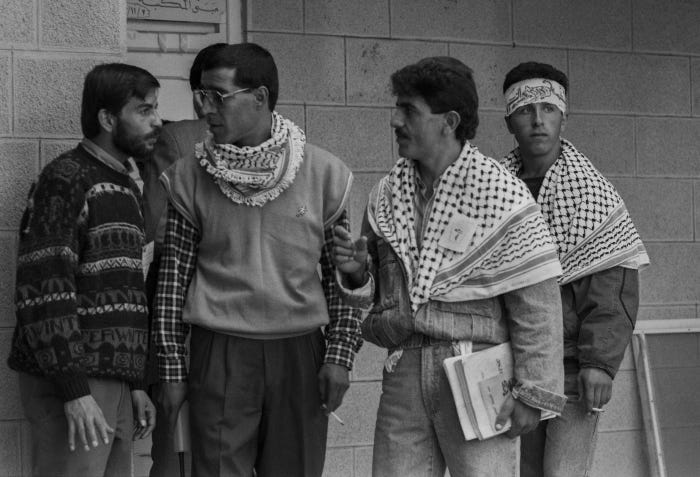Sartorial expressions of faith, freedom and politics
A scarf with political sentiment, what you can learn about Muslim style and a call for new essays.
Hello everyone,
This week’s letter profiles a popular scarf, brings you resources on Muslim sartorial expression and puts out a call for long form content.
Objects That Matter: The Palestinian Keffiyeh
The politicized history of the keffiyeh can be dated back to The Arab Revolt in Palestine (1936-1939). When the occupation of Palestine proceeded under the British Mandate, guerilla forces adopted the scarf, wrapping it around the face to avoid identification and arrest. When the keffiyeh was banned as a result, all Palestinians wore the scarf as a tactic to allow resistance forces to move through communities safely.
This week Research Assistant Safia Sheikh is guiding our examination of Muslim fashion and style. Starting things off, Safia selected a commonly appropriated ‘accessory’– the Palestinian Keffiyeh. This item circulated quickly through retail spaces like Urban Outfitters–a consumer environment influential in shaping the youth market’s taste as they explore various cultures, ideologies and lifestyles. The problem with these capitalistic, impressionable spaces is that the loaded cultural significance and historical context of shop-able objects is scrubbed away and marketed for unmindful consumption. We invite you to explore Safia’s profile of this politically symbolic scarf, and we hope that it will inspire you to be more conscious of your shopping and styling practices.

Dray, Joss. Student Council Elections, Birzeit University, ca.1992, still image (negatives). The Palestinian Museum, Birzeit.
Is there an object you’d like to write about and add to our growing canon of marginalized or mis-appropriated fashion? Pitch the object via our contributor page.
The Library: Muslim Fashion
Our Library provides an ever-expanding collection of resources on ‘race,’ with its ideological and aesthetic influence shaping both history and our modern lives.
As we work to expand the narrative and visual landscape of fashion history and illuminate the interconnected nature of dress, adornment, selfhood and social politics, our Library has amassed numerous sources on Muslim fashion. By no means a monolith, Muslim identity and sartorial expression is richly vast and intersects with not only expressions of faith, but gender, race, class and personal politics.

Photo: "Women with bun-style headscarves" from ’Hoodjabis and Muslim Dandies: How Fashion Intersects with Race, Gender, Class, and Muslim Identity (Article by Su’ad Abdul Khabeer)
Check out this roundup of sources that showcase the breadth of Muslim, fashioned identities and the politics involved, curated by Research Assistant Safia Sheikh:
1. Modest Fashion: Styling Bodies, Mediating Faith by Reina Lewis (book)
2. Veil: Modesty, Privacy and Resistance by Fadwa El Guindi (book)
3. ‘Beards, Braids and Moustachios: Exploring the Social Meaning of Hair in the Medieval Muslim World’ by Petra M. Sijpesteijn (article)
4. ‘’Hoodjabis and Muslim Dandies: How Fashion Intersects with Race, Gender, Class, and Muslim Identity’ by Su’ad Abdul Khabeer (article)
5. ‘Marketing the Muslim Woman: Hijabs and Modest Fashion Are the New Corporate Trend in the Trump Era’ by Rashmee Kumar (article)
We add new sources weekly, so head over to The Library for a full spectrum of books, articles, videos and podcast episodes that further explore this topic.
Call for Contributors: Essays, Opinion and Research
As we mentioned last week, substantial fundraising efforts has enabled us to ‘green light’ the countless pitches for new content that we have received over the past two months (even in the past two weeks!). Next month, you will start seeing numerous original essays, opinion pieces and guest posts for our ‘Objects That Matter’ section. We especially invite long articles and opinion pieces, and here’s some ideas:
Long essays (1,200-1,500 words) that include addressing social or topical issues, storytelling or sharing sections of academic or creative/design research
Short opinion pieces (500-800 words) that tackle an issue present in fashion culture today as it relates to race/ethnicity, broadening narratives of history or under-represented topics
If you’d like to contribute, please go to our ‘Contact Us’ page and select ‘Pitch for new content.’
See you next week! Yours in service and solidarity,
The Project Team
(Kim, Rachel, Adriana, Safia)



